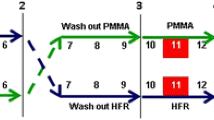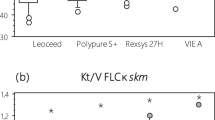Abstract
Background/Aims
Serum free light chain (FLC) levels are correlated with chronic kidney disease (CKD) stages and are highest in patients on hemodialysis (HD). Aim of this study was to assess the FLC removal efficiency of Elisio™-210H dialyzer using either high-flux HD or on line high efficiency hemodiafiltration (HDF) modalities in CKD-5D patients.
Methods
In this prospective and comparative study, 20 CKD-5D patients free from multiple myeloma were randomized in two groups: HD versus on line HDF. All patients were dialyzed with Elisio™-210H dialyzer. Serum samples were collected before and after the midweek dialysis session, before randomization and at the end of the study to measure κ and λ FLC concentrations. Reduction ratios were corrected for net ultrafiltration.
Results
For both HD and HDF mode, κ and λ FLC concentrations were significantly lower after dialysis than before but median reductions in κ and λ FLC levels were significantly higher in HDF versus HD groups (κ 73.5 vs. 65.5 %, p = 0.04 and λ 51.0 vs. 36.6 %, p = 0.07). After dialysis, all κ/λ ratio values were between 0.26 and 1.65 which is the reference range described in subjects with normal kidney function, for both HD and HDF groups (median κ/λ ratios were 0.80 [0.47–1.22] and 0.67 [0.50–0.79] respectively).
Conclusion
This study shows the superiority of on line HDF compared with HD to remove both κ and λ FLC. Moreover, all post-dialysis κ/λ ratios reached normal reference range.

Similar content being viewed by others
References
Bradwell AR (2008) Serum free light chain analysis, 5th edn. The Binding Site Ltd, Birmingham
Wakasugi K, Sasaki M, Suzuki M, Azuma N, Nobuto T (1991) Increased concentrations of free light chain lambda in sera from chronic hemodialysis patients. Biomat Artif Cell Im 19:97–109
Cohen G, Rudnicki M, Schmaldienst S, Hörl WH (2002) Effect of dialysis on serum/plasma levels of free immunoglobulin light chains in end-stage renal disease patients. Nephrol Dial Transplant 17:879–883
Bradwell AR, Carr-Smith HD, Mead GP, Tang LX, Showell PJ, Drayson MT, Drew R (2001) Highly sensitive, automated immunoassay for immunoglobulin free light chains in serum and urine. Clin Chem 47:673–680
Ward RA (2005) Protein-leaking membranes for hemodialysis: a new class of membranes in search of an application? J Am Soc Nephrol 16:2421–2430
Hutchison CA, Cockwell P, Reid S, Chandler K, Mead GP, Harrison J, Hattersley J, Evans ND, Chappell MJ, Cook M, Goehl H, Storr M, Bradwell AR (2007) Efficient removal of immunoglobulin free light chains by hemodialysis for multiple myeloma: in vitro and in vivo studies. J Am Soc Nephrol 18:886–895
Katzmann JA, Clark RJ, Abraham RS, Bryant S, Lymp JF, Bradwell AR, Kyle RA (2002) Serum reference intervals and diagnostic ranges for free kappa and free lambda immunoglobulin light chains: relative sensitivity for detection of monoclonal light chains. Clin Chem 48:1437–1444
Hutchison CA, Plant T, Drayson M, Cockwell P, Kountouri M, Basnayake K, Harding S, Bradwell AR, Mead G (2008) Serum free light chain measurement aids the diagnosis of myeloma in patients with severe renal failure. BMC Nephrol 9:11
Granger Vallée A, Chenine L, Leray-Moragues H, Patrier L, Cognot C, Cartron G, Cristol J-P, Canaud B (2011) Online high-efficiency haemodiafiltration achieves higher serum free light chain removal than high-flux haemodialysis in multiple myeloma patients: preliminary quantitative study. Nephrol Dial Transplant 26:3627–3633
Bergström J, Wehle B (1987) No change in corrected beta 2-microglobulin concentration after cuprophane haemodialysis. Lancet 1:628–629
Leypoldt JK, Cheung AK (1992) Deeter RB (1997) Single compartment models for evaluating beta 2-microglobulin clearance during hemodialysis. ASAIO J 43:904–909
Haynes R, Hutchison CA, Emberson J, Dasgupta T, Wheeler DC, Townend JN, Landray MJ, Cockwell P (2011) Serum free light chains and the risk of ESRD and death in CKD. Clin J Am Soc Nephrol 6:2829–2837
Gondouin B, Scherberich JE, Bevins A, Cockwell P, Hutchison CA (2011) A potential use of polyclonal free light chain levels for monitoring in a chronic dialysis population. Poster presented at the 48th ERA-EDTA congress. Prague, Czech Republic
Desjardins L, Liabeuf S, Lenglet A, Lemke H-D, Vanholder R, Choukroun G, Massy ZA, Group EUTEW (2013) Association between free light chain levels, and disease progression and mortality in chronic kidney disease. Toxins 5:2058–2073
Hutchison CA, Burmeister A, Harding SJ, Basnayake K, Church H, Jesky MD, White K, Green CE, Stringer SJ, Bassett P, Ferro CJ, Cockwell P (2014) Serum polyclonal immunoglobulin free light chain levels predict mortality in people with chronic kidney disease. Mayo Clin Proc 89:615–622
Lamy T, Henri P, Lobbedez T, Comby E, Ryckelynck J-P, Ficheux M (2014) Comparison between on-line high-efficiency hemodiafiltration and conventional high-flux hemodialysis for polyclonal free light chain removal. Blood Purif 37:93–98
Pasquali S, Iannuzzella F, Corradini M, Mattei S, Bovino A, Stefani A, Palladino G, Caiazzo M (2015) A novel option for reducing free light chains in myeloma kidney: supra-hemodiafiltration with endogenous reinfusion (HFR). J Nephrol 28:251–254
Hutchison CA, Harding S, Hewins P, Mead GP, Townsend J, Bradwell AR, Cockwell P (2008) Quantitative assessment of serum and urinary polyclonal free light chains in patients with chronic kidney disease. Clin J Am Soc Nephrol 3:1684–1690
Acknowledgments
FREELITE immunoassay kits were provided with the compliments of The Binding Site (Birmingham, UK). This study was supported by Nipro Corporation, Japan.
Conflict of interest
Chloé Bourguignon, Leïla Chenine, Anne Sophie Bargnoux, Hélène Leray-Moragues, Jean-Paul Cristol and Marion Morena have no conflicts of interest to declare. Bernard Canaud is a full-time employee of Fresenius Medical Care. The research conducted was sponsored by Nipro Corporation.
Ethical approval
The study was conducted in accordance with the principles of the Declaration of Helsinki and in compliance with the International Conference on Harmonization/Good Clinical Practice regulations. In accordance with French Law, the study was approved by our Institution’s ethical committee with the following number 2008-A00852-53. The study was also registered at clinicaltrials.gov (NCT01653808).
Informed consent
Informed consent was obtained from all individual participants included in the study.
Author information
Authors and Affiliations
Corresponding author
Rights and permissions
About this article
Cite this article
Bourguignon, C., Chenine, L., Bargnoux, A.S. et al. Hemodiafiltration improves free light chain removal and normalizes κ/λ ratio in hemodialysis patients. J Nephrol 29, 251–257 (2016). https://doi.org/10.1007/s40620-015-0207-z
Received:
Accepted:
Published:
Issue Date:
DOI: https://doi.org/10.1007/s40620-015-0207-z




